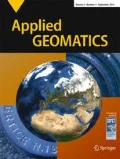Abstract
The GLONASS (Global Navigation Satellite System) is a satellite positioning system able to provide various numbers of air, marine, and any other type of users with all-weather three-dimensional positioning, velocity measuring, and timing anywhere in the world or near-earth space. As known, a GLONASS receiver performs passive measurements of pseudoranges and pseudorange rate of at least four GLONASS satellites as well as receives and processes navigation messages contained within navigation signals of the satellites. The navigation message supplies the satellites' position both in space and in time. Combined processing of the measurements and the navigation messages of the four (three) GLONASS satellites allows users to determine three (two) position coordinates, three (two) velocity vector constituents, and to refer user time scale to the national reference time UTC (SU). The purpose of this work was to define a stochastic model for pseudorange variances of GLONASS satellites able to provide its estimation. This evaluation is made for all satellites as a function of the elevation, independently of the user position, starting from real data. To achieve this goal, a suitable software tool MATLAB® is developed. The tool is able to create a GLONASS sky from the broadcast ephemeris, to compute the pseudorange error and to process it. The used data are extracted from observation and navigation RINEX files (containing both GPS and GLONASS measures). From the known receiver position and the computed satellite coordinates, the geometric range is obtained and compared with the pseudorange measurement, in order to achieve the pseudorange variance and build the model. In order to validate the sigma stationary stochastic model, the results are compared with further data obtained from different stations. The purpose of this work was the creation of an σ model particularly adapted in application as personal navigation device, characterized by the need of a real-time positioning and by a low computational power. The accuracy in real-time positioning can be improved, using a weighted least square (WLS) method for GNSS (GPS, GLONASS, and in the future GALILEO or other feasible systems) measurements. For GPS measurements, several suitable σ models for the WLS implementation are already in use; for GLONASS (or GLONASS-GPS together), the same is not available. So, there is need of studies about this topic.












Similar content being viewed by others
References
Barnes, B.J., Ackroyd, N. and Cross, P.A. (1998): Stochastic modelling for very high precision real-time kinematic GPS in an engineering environment, FIG XXI International Conference, Brighton, U.K., 21-25 July, Commission 6, pp. 61–76.
Borre, K. and Tiberius, C. (2000): Time Series Analysis of GPS Observables. In Proceedings of The 13th International Technical Meeting of the Satellite Division of the Institute of Navigation GPS 2000.
Cross PA, Hawksbee DJ, Nicolai R (1994) Quality measures for differential GPS positioning. The Hydrographic Journal 72:17–22
Eissfeller, B. (1997): Ein dynamisches Fehlermodell fur GPS Autokorrelationsempfanger, Schriftenreihe Studiengang Vermessungswesen, Universitat der Bundeswehr, Munchen, Heft 55, 1997
GLONASS Interface Control Document (version 5.0) ICD 2002.
Gurtner, W. (2001): RINEX: The Receiver Independent Exchange Format Version 2.10, 2001.
Han S (1997) Quality control issues relating to instantaneous ambiguity resolution for real-time GPS kinematic positioning. Journal of Geodesy 71:351–361
Leick, A. (1995): GPS Satellite Surveying, John Wiley & Sons, Inc., Second edition, 1995
Misra, P., Pratt, M. and Burke, B. (1998): Augmentation of GPS/LAAS with GLONASS: Performance Assessment, ION GPS-98, page 495.
Mitrikas, V.V., Revnivykh, S.G. and Bykhanov, E. V. (1998): WGS84/PZ90 transformation parameters determination based on laser and ephemeris long-term GLONASS orbital data processing, Proceedings of ION GPS-98, Nashville, Tennessee, September 15–18, 1998
Papoulis, A. (1991): Probability, Random Variables, and Stochastic Processes, third Ed., 1991 McGraw-Hill.
Proakis, J.G. (2001): Digital Communications, 4°th Ed., 2001, Mc Graw-Hill.
Rizos C., Han S. and Hirsch B. (1997): A high precision real-time GPS surveying system based on the implementation of a single-epoch ambiguity resolution algorithm, Proceedings of the 38th Australian Surveyors Congress, 12-18 April, Newcastle, Australia, 20.1-20.10
Roßbach, U. (2000): Positioning and Navigation Using the Russian Satellite System GLONASS (PhD thesis).
Satirapod, C. (2004): A review of stochastic models used in static GPS positioning technique, 25 th ACRS & 1 th ASC, November 22–26 2004, Thailand
Satirapod, C. and Wang J. (2000): Comparing the quality indicators of GPS carrier phase observations, Geomatics Research Australasia, No 73, pages 75–92.
Satirapod, C., Wang, J. and Rizos, C. (2001): A Simplified MINQUE Procedure for the Estimation of Variance-Covariance Components of GPS observables. Geomatics Journal of Hong Kong
Teunissen PJG (1997) On the sensitivity of the location, size and shape of the GPS ambiguity search space to certain changes in the stochastic model. Journal of Geodesy 71:541–551
Viandier, N., Nahimana, D.F., Marais, J. and Duflos, E. (2008): GNSS Performance Enhancement in Urban Environment Based on Pseudorange Error Model, IEEE/ION PLANS 2008.
Wang J. (1998): Stochastic assessment of the GPS measurements for precise positioning, 11th Int. Tech. Meeting of the Satellite Division of the U.S. Inst. Of Navigation GPS ION’98, Nashville, Tennessee, 15-18 September, 81–89.
Wang J, Stewart MP, Tsakiri M (1998) A discrimination test procedure for ambiguity resolution on-the-fly. Journal of Geodesy 72:644–653
Wang, J., Satirapod, C., and Rizos, C. (2001): Stochastic assessment of GPS carrier phase measurements for precise static relative positioning, Submitted to Journal of Geodesy
Author information
Authors and Affiliations
Corresponding author
Rights and permissions
About this article
Cite this article
Gaglione, S., Angrisano, A., Pugliano, G. et al. A stochastic sigma model for GLONASS satellite pseudorange. Appl Geomat 3, 49–57 (2011). https://doi.org/10.1007/s12518-011-0046-0
Received:
Accepted:
Published:
Issue Date:
DOI: https://doi.org/10.1007/s12518-011-0046-0




